


Our Plot at Green Lane Alloments Blog | Our Weather Blog | School Vegetable Patch Website | School Vegetable Patch Blog
© Our Plot on Green Lane Allotments -
7 June
During the first week of June the seasons collided and we were left wondering just where in the year we actually had landed.
At the beginning of the week we were in midsummer with temperatures of 26°C and it was more comfortable to garden in the shade of the gazebo. Then the temperature plummeted and the weather changed and we were left to wonder whether it was winter, autumn or early spring. Goodness knows what the plants made of it all but thankfully they carried on growing regardless.
It was a lovely morning when radio Leeds visited to broadcast on the Breakfast Show. We had breakfast on the plot with a soundtrack of birdsong.
The strawberries and redcurrants were just beginning to turn red and so the most important task was netting both to try and prevent the birds from getting to the ripe fruits before we did. All the while we were working on plant protection the blackbirds were chuntering in disgust. No doubt they had been eyeing the fruits ready to swoop in at the first signs of ripeness.
The remaining rhubarb – Champagne & Raspberry Red was planted out.
At the beginning of the week the first batch of runner beans – Lady Di were planted around a tepee of bamboo canes. The next day we were warned that we may have a late frost so that was a bit of a worry with many tender plants already in place but fortunately everything survived and seems no worse for the drop in temperature.
The carrots were in desperate need of weeding and so we had to risk the chance that carrot fly may sneak in and remove the enviromesh. It was thought to be the lesser of two evils as the weeds were in danger of smothering the young carrots. The carrots had germinated well and having weeded we were left with rows with hardly a break. Usually we do have some bare patches.
The volunteer potato shoots (ones resulting from tubers accidentally left in the soil last year) were weeded out from amongst the dahlias. These are
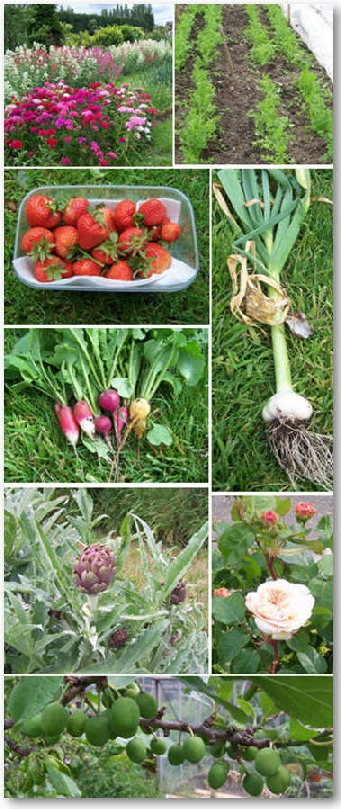
growing in the area that suffered from herbicide contamination last year. As dahlias are also sensitive to the herbicide residue we have been watching their progress with fingers crossed and so far no sign of any problems. Some potato shoots however, have shown symptoms of herbicide damage.
The beginning of the weekend was wet and so the only activity was harvesting. We now have a steady supply of salad leaves and radish.
We also harvested the first gathering of strawberries – a real highlight and made possible only by the fact that the netting had done its job. Unfortunately netting can’t protect against browsing slugs which had been encouraged out by the wet weather and one or two berries were nibbled.
Having used up our store onions, we harvested the first of the overwintered onions – Red Cross. Another first harvest was that of one of the garlic varieties grown over winter in a tub. This was experimental as we weren’t really sure whether it was ready or not but the plant had produced a plump bulb of cloves.
The globe artichokes are now produced the huge flower buds. We inherited the plants and never harvest them. To be honest I don’t think they are worth the trouble of preparing and cooking but the bees absolutely adore the flowers.
The sprinkling of flower buds on the kiwi plants continue to swell but as yet no sign of flower.
We also continue to gather rhubarb and cabbage. Herbs too are in ready supply and add to the flavour of our mixed salad leaves.
Sweet Williams are providing us with an ample supply of cut flowers. The shrub roses are also now blooming with the added bonus of strong perfume.
At the end of the weekend we had decided rain or not we would have to give the pea plants some support – fortunately luck was with us and it remained dry so we were able to do this without getting soaked.
The plot greenhouse as well as housing a few early planted salad crops is now planted out with the various varieties of tomatoes. The ones planted earlier are growing well and beginning to flower. These have been provided with canes for support and side shoots are being removed from the plants where this is appropriate.
In the garden greenhouse the pineapple sage plant is growing well and has been transferred to a larger pot.
It bought a few herb plants this week which are destined to be planted together in a couple of wooden tubs and placed just outside of the greenhouse in the garden. Some are for cooking but other just looked or smelled nice. So far I have bought, garlic chives, Dartington curry plant, compact marjoram, broad leaved thyme, variegated thyme, variegated sage – Icterina and a small bay plant. I’ve also dug up a small clump of ordinary chives from the plot to add to the collection.
Lots of seeds were sown this week namely:
- the final set of courgettes – Zucchini, Clarita & Floridor
- a second sowing of climbing French Beans – Corona D’Oro. The first sowing of these failed. Last year this variety was difficult but we decided to try again. I wonder if yellow varieties are more problematic.
- yet another variety of salad greens, lettuce – Romaine Ballon acquired free with a magazine.
- two varieties of foxglove – Excelsior & Foxy. Foxy is a shorter variety
- Sweet William – single mixed
- Pansy – Universal Mixed
The foxgloves and sweet William are biennial plants which means we are sowing now when plants sown last year are actually flowering.
The pansies are to hopefully provide a bit of colour in tubs over winter.
We pricked out a second sowing of sweet corn – Honey Bantam, some red cabbage – Ruby Ball, cauliflower – Autumn Giant and kale – Nero di Toscana and salad leaves – Provence Mixed and Tuscany.
A collection of fuchsia plants arrived, 10 trailing –Dark Eyes, Eva Boerg, La Campanella, Southgate & Swingtime and 10 uprights-
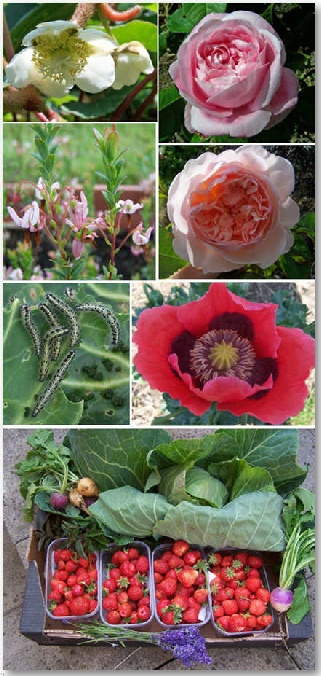
14 June
The highlight of this week just has to be the strawberries. We have gorged ourselves on them and even given some away. We have managed to pick about 12 punnets -
The plot is filling up well and we are now almost at the stage where we have to start searching for gaps in which to squeeze the remaining plants.
We have a large area on our plot dedicated to fruit. Most is showing promise of a good harvest but we have one or two disappointments.
The cherry which was planted a couple of years ago hasn’t yet fruited but this year it looked as though we were going to have at least a bowl full of cherries to test, The fruits are now turning red but are still very small and solid so it looks as though we will have to wait another year.
The blackcurrants are another disappointment; the bushes have suffered a severe aphid infestation which has left them and cuttings that were taken last year struggling to hang on to their leaves let alone fruit. The tips of the gooseberries are also displaying the curling and sticky leaves that are typical of aphid damage but fortunately seem not to be too badly affected.
Aphids do seem to be a major problem this year. Our plums and gages suffered an attack in spite of having been treated to a winter wash. Each year we give the plums and gages a winter wash. Before we started to do this each year the trees lost most of their first flush of leaves because of aphid damage. The fruit was also often deformed. This year, due to poor weather at the time, we only managed one application of winter wash and so although not as severe the trees have been attacked by plum aphid. In spite of this and even after the June drop we look to be going to have a good harvest of plums and gages. Some of the branches of our largest plum tree has needed propping so that the fruits are not trailing onto the grass making them an easy prey to slugs. The plum and apple trees have also had some branches removed or cut back. Pruning of plums and other stoned fruit has to be carried out now to avoid any resultant silver leaf fungal disease.
When weeding the parsnips I came across three ants nests. Well I actually dug them up. On turning the soil I noticed tiny bits of white scattered on the surface. On closer inspection I saw lots of tiny ants scurrying around and collecting the tiny white objects, which were in fact their larvae, and rushing back underground. Other than when I dig up their nests the ants are no doubt enjoying a good year. They feed on the sticky honeydew that is excreted by aphids and actually farm the aphids by ‘milking’ them and protecting them from their predators. I spotted one such predator that is more than welcome in the garden – the ladybird larvae. As with most insects ladybird young look nothing like their parents. If you can’t recognise a young ladybird so you can avoid inadvertently squashing these gardeners’ friends, click here to view a short video clip.
On the plot there was also lots of planting out of the following:
- Squash – Crown Prince & Turk’s Turban
- Lettuce – Iceberg & Little Gem
- Climbing French beans – Barlotta lingua di Fuoco & Cosse Violette.
- Tomatoes – Roma
- Beetroot – Sunset Mixed (a mixture of Boltardy, Golden, Chioggia & Blankoma)
- Calabrese -
Green Magic & F1 Samson - Sunflower Autumn Time & Cutting Mixed
- Annual Chrysanthemums, Rainbow Mixed
We planted out a second batch of sweetcorn – Honey Bantam. Sweetcorn is wind pollinated and so is planted in a block rather than in rows. As the sweetcorn planted this week was a different variety it has been planted well away from our first planting to avoid cross pollination.
French marigolds -
The sweet Williams continue to provide us with cut flowers and the shrub roses are now joining them. We chose the varieties for their perfume and colour. To me a rose without perfume is like an apple with no taste. Have you noticed that whenever someone sees a rose the first thing they tend to do is bury their rose in it to test whether it has a scent?
The seed sowing also continued. Seeds sown were:
- Another sowing of radish – French Breakfast 3, Rainbow Mixed, Yellow and a radish called Hilds Blauer Herbst und Winter. The later was from a packet being given away by one of our magazines. It is supposedly a large purplish radish that can be stored so I await the results with interest.
- More spring onion – Ishikuro & Guardsman
- Broccoli – Late Purple Sprouting, Raab, White Eye & Early White Sprouting
- French beans – Delinel
- Florence fennel – Sirlo
- Swede – Marian
We have also made another sowing of climbing French beans Cosse Violette as an insurance against second failure of the yellow climbing French beans – Corona d’Oro which seem to be loathe to germinate.
Two cucumbers – Burpless Tasty Green, were planted in the plot greenhouse. More cucumbers and aubergine – Black Enorma were planted up in the garden greenhouse which is gradually becoming less full of plants awaiting transfer into the great outdoors.
The grapevine in the greenhouse which is dripping with embryo fruits was trimmed back. Failure to keep up with this leads to a greenhouse completely full of grape vine and little else.
Work in the garden has also moved on. The area alongside the greenhouse has now been completed. It now houses a selection of tubs and troughs which have been planted up with impatiens, nemesia – Carnival Mixed & mesembryanthemums and the herbs that were bought last week. Space has been left for fuchsias and more herbs. The sage cuttings – purple leaved and a green leaved variety, taken earlier have now rooted and potted on and the tips nipped out to encourage the cuttings to bush out. Cuttings have been taken from the variegated thyme growing on the plot to provide another herb to add to our garden collection.
One area that was less than successful last year was an area around one of our birdbaths. It was RSPB Nature count this week and true to form bird activity seemed to be in decline however, the bath is generally so well used that the ground around it is permanently soggy. Last year it was planted up with impatiens that really struggled and so this year some ferns have been planted around the base of the bird bath with a few impatiens planted in the drier area around them. I hope that this will be a more successful planting but only time will tell.
And finally my husband has dared to drill holes in the number plaque that I painted for our shed so now it isn't just the Sunderlands that have a shed adornment!
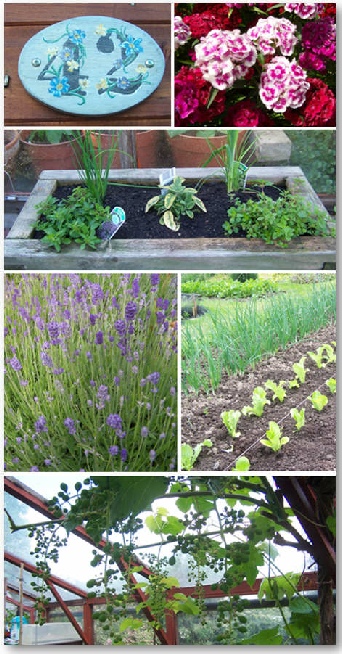
21 June
Excitement this week as the kiwi flowered for the first time. Maybe the degree of excitement was excessive taking into account that there were only five buds on the two plants and so far only three had actually opened. The chance of any fruit is very unlikely but it is a step in the right direction and who knows – next year the plants may be dripping with flowers!
Self sown poppies are springing up in the most unlikely places including the compost heap. Wherever possible these are just left to do their thing. Where they come from is amazing. We did have some double pink annual poppies one year but the ones coming up now are all sorts of colours.
The cranberry plants are flowering well – we haven’t really had much fruit from these plants yet. It was for this reason that I dug them up and planted them in containers in which the plants seem to be flourishing so we will see whether this improves fruit development too.
The shrub roses are now looking and smelling lovely as is the lavender. The poached egg plants (limnanthes) that had provided a vibrant carpet under the roses had begun to die back and look scraggy and so they have been removed. Poached egg plants self seed and so come late autumn we will need to be ruthless in culling them to leave a manageable number. They are really bright, cheerful flowers much loved by beneficial insects but you can have too much of a good thing.
This week after being bombarded for a few years now with information about making comfrey fertiliser, we finally got round to creating what we have christened the comfrey still. We are going to try the dry leaf method – less smelly. I can really vouch for that as our plot neighbours are using the soaking in water method and when the stuff is released from the barrel it can be smelled a mile off. Our method is to stack comfrey leaves in a container and weigh them down with a couple of bricks. Liquid is then squeezed from the pile and drips out of a hole in the bottom of the container and into a jar. This liquid is then diluted 20 parts water to one of comfrey juice. As the level of comfrey leaves fall the pile is topped up. Whether we have our own miracle fertiliser or not remains to be seen!
The patio area outside of the shed or cabin as one visitor referred to it is being widened a little to create a slightly wider shady area. The major task is the transportation of the old paving slabs from the garden to the plot.
The windy conditions this week have played havoc with the broad beans in particular causing some plants to be almost horizontal; however some beans are nearly ready for picking so it seems no real harm has been done.
Planting has continued this week although space is fast becoming a rarity. Outdoors we have planted:
- Cauliflower – Autumn Giant & Kaleidoscope Mixed.
- Leeks -
Giant Winter & Autumn Giant - Tomato – Shirley & Moneymaker
- Courgette – Floridor, Clarita & Zucchini
- Squash – a mixture of varieties
A mixture of aubergine, peppers, chillies and melons which were left over after filling our greenhouses. They will either grow or fail completely but we didn’t really have anything to lose in trying. I guess it will depend on the weather.
To add colour we also planted more nemesia, mesembryanthemum, French marigold & nicotiana amongst the fruit bushes.
All the brassica are now protected with butterfly proof netting – well that is the theory but no doubt one or two persistent insects will find their way in. The netting will also double up as protection against wood pigeons.
The spring cabbage – Excel that had been supplying us with vegetables during the lean period wasn’t covered and was attacked by caterpillars of the Large White Butterfly. They were more or less over and so have been cleared. We still have a supply of cabbages for the table as the Primo 2 variety are now being harvested.
Seeds continue to be sown in the greenhouse:
- Climbing French beans – Barlotto
- Foxgloves – Foxy & Excelsior Mixed
- Broccoli – Late Purple Sprouting, Raab & White Eye have been pricked out.
We are now really beginning to reap what we have sown and harvesting is now as much a feature of our week as the planting and weeding.
The strawberries just keep on coming and coming and coming, punnet after punnet and long may it continue! We also have a good supply of salad leaves, radish and herbs.
The Yellow and Rainbow Mixed radish although rather large are still good to eat. They haven't become hollow as have the variety French Breakfast 3 and just need slicing. We have begun harvesting turnips, which were only just a tiny bit larger than the radish. We use them when they are just slightly larger than golf balls. Our first planting of peas were set in pots in the greenhouse, and then planted out on the plot. They haven’t grown as strongly as those directly sown outdoors but have provided us with a few helpings of early peas.
We have begun to harvest our winter onions which should see us through until the onions planted this year are ready. The winter onions don’t store well so are pulled as required.
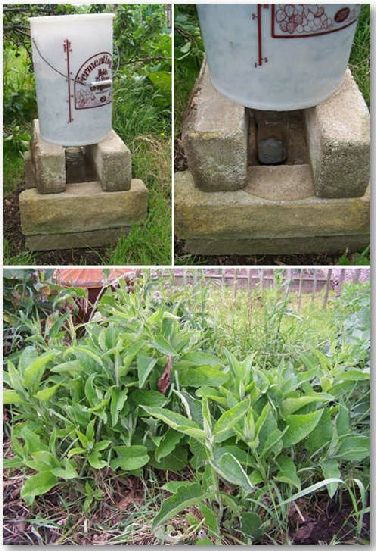
We now have a really good variety of salad leaves but conscious of the need to keep this supply going through the season more have been sown in the greenhouse and directly into the ground. Varieties include, Yugoslavian Red, Iceberg 2, Little Gem, Balloon, Saladisi and a mixed pack of salad leaves supplied courtesy of the National Trust.
The first sowing of radish are now becoming woody and so will be discarded, however some – Rainbow Mixed and a yellow trial variety -
We tested our Juliette potatoes by lifting one plant but these need a little more time before they are ready to harvest, however our plot neighbours have kindly supplied us with a few helpings of their earlies.
The garlic that was growing in a tub has been pulled and is drying off. Also harvested are:
- The first gooseberries – a red dessert variety
- Peas – Kelvedon Wonder
- Winter onions – Troy & Red Cross
- Rhubarb – Giant Crimson
- Broccoli – Olympia
- Cabbage – Primo 2
- Herbs – mint & sage
Another tepee of climbing French beans – Cosse Violette has been planted up. The teppee should have been home to a yellow variety but the seeds just don’t seem to want to germinate so we have had to replace them with stand-
The first lot of courgette plants are now growing well; they always seem to need a while to acclimatise after being planted out, now baby courgettes are developing. Soon everyone on site with a glut of these fruits will be desperately trying to find someone else on the site who hasn’t grown their own and will take some off their hands. It can be a battle to find a willing recipient before anyone else gets to them.
The first squash plants are also beginning their growth spurt. I am trying to grow a couple up supports so have started to tie them in. I don’t know how this will work so watch this space!
28 June
The focus on the plot this week has turned from planting and sowing to harvesting and caring for the growing plants. It’s been a week where the mornings have threatened rain which has never come as the afternoons have been very warm with outbreaks of sunshine. This has meant plenty of exercise watering thirsty plants.
The strawberries just keep on coming – we are eating and drinking strawberries with new supplies being gathered daily. Any that we can’t devour are being made into jam or given away. Last year’s alpine strawberry plants were producing berries but the plants looked very bedraggled so I decided to take a risk and go over them all with a pair of shears. If they survive and refresh themselves then great; if not we will have to make do with memories of our June glut of their larger cousins and look forward to next year. We grew a second variety of alpines this year-
Our second bumper harvest has begun – redcurrants. This year the redcurrants have ripened quickly meaning that whole strands of berries have ripened at the same time. One day I had unexpected company as I was sitting gathering strands of berries. As protection against birds the berries are netted, however a blackbird was sitting on the cane support frame gathering the berries that it could reach by pushing against the netting. We just carried on harvesting together – there was plenty for both of us. Once we have gathered plenty of berries we usually remove the nets to allow the birds to finish off the job but it seems that for some reason they are less keen to gather these easy pickings. I suppose it’s a case of forbidden fruit being more attractive.
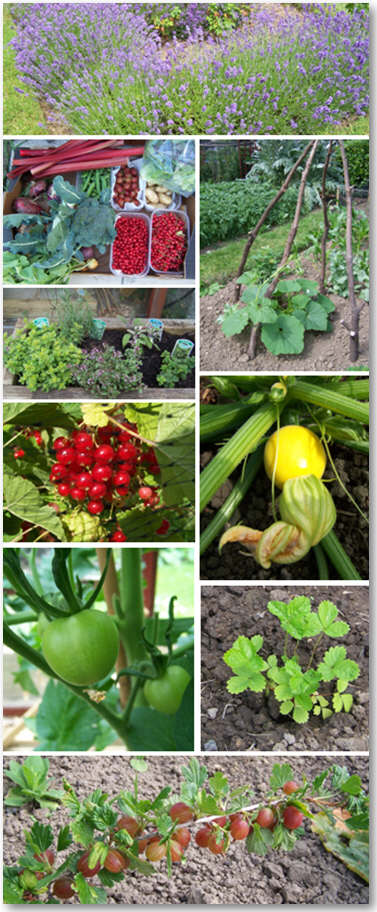
One set-
A different bird is proving to be a worthy ally. A song thrush was seen battering a snail shell in order to get to the occupant and make a meal of him/her. Actually it is both him and her! I’m not sure how many song thrushes we have visiting the site but around our plot are several small piles of snail shells. Usually a smooth stone is located nearby that the bird uses as an anvil on which to crack open the shell so I am always careful when weeding to replace any flat stones that are found near to piles of broken shell.
One of our new grapevines – Madeline Sylvaner – has been planted on the plot. Hopefully it will grow up the arch that spans the path between ours and the next plot. There will be no grapes this year but that will be something to look forward to.
The kiwi flowers that caused such excitement last week have now dropped off leaving no signs of any developing fruits. It was highly unlikely that any fruits would be produced as we had just five flowers only two of which were open at any given point. As these were on the same plant there was no chance of any cross pollination so maybe next year we will move on to the next step and have more flowers and maybe a couple of fruits! Gardening is a real test of patience and staying power!
More self-
The lavender is in full flower now and is also proving to be very attractive to the bees. The roses too are flowering well although a few leaves have shown the symptoms of blackspot. These were removed and taken home to the wheelie bin to try and avoid spreading the disease further. Faded blooms are dead haeaded to encourage more buds. The foxgloves too have had the spent flower spikes removed. I don’t really want them to seed everywhere as they tend not to be true to variety. So each year we sow freshly bought seed. The dahlias are just beginning to send up the first flowers. This year we intend to keep a note which plant produces which flowers. Planting this season has been a case of pot luck!
The bottom few leaves of the cardoons have been removed to let a bit air circulate and also to prevent them interfering with plants growing close by. They have reached gigantic proportions and so far this year seem to have survived the winds that usually batter them.
In the garden the perennial beds are filling up and providing colour. The bedding plants too which have been planted in tubs and to fill gaps in the flowerbeds are growing quickly.
More herbs – oregano Hot n Spicy, sage tricolor, oregano Country Cream, a silver leaved thyme and Dartington curry plant were planted to create a second trough of mixed herbs. A sage that was grown from a cutting a month or so ago has been given a pot to itself as it will grow too vigorously to share its quarters.
Upright fuchsias have been added to our tubs of bedding plants. The collection bought a week or two ago have seemed to struggle. Ones not planted into tubs have been repotted into a different compost in an attempt to revive them. The compost that we have used this year seems to have produced really variable results.
A banana tree that was suffering a bit in the shade cast by the crab apple tree has now been moved to a lighter position. At the moment it is in a large tub so we can see if it likes its new home before committing it to long term life in its new spot.
In the garden greenhouse the grape vine is dripping with embryo bunches of grapes and the first tomatoes have set. The trays of seeds have now given way to a display of streptocarpus and pelagoniums.
The garden pond has also had a bit of attention. The watercress that appeared out of nowhere to take over much of the pond has been removed. No doubt some bits will have remained to attempt recolonisation so we will need to be vigilant. The iris has been severely cut back and a new collection of plants have been planted around the margins – Mimulus Ringens (Lavender Musk), Mimulus Lutens (Monkey Musk), Lobelia cardinalis and Carex Muskingumensis (Umbrella Flat Sedge).
We have also redesigned our heron proofing. The original panic measure was to cover the pond using black netting but this meant that planting was restricted and so we have now used black corded string which is stretched across the pond at various points. Hopefully the heron won’t manage to get to the fish but the plants will be able to grow through the gaps.
This week’s good weather has meant we can enjoy sitting by the pond watching the fish gliding around with the scent of honeysuckle and jasmine wafting around us. Just hope this lasts for a while longer!
